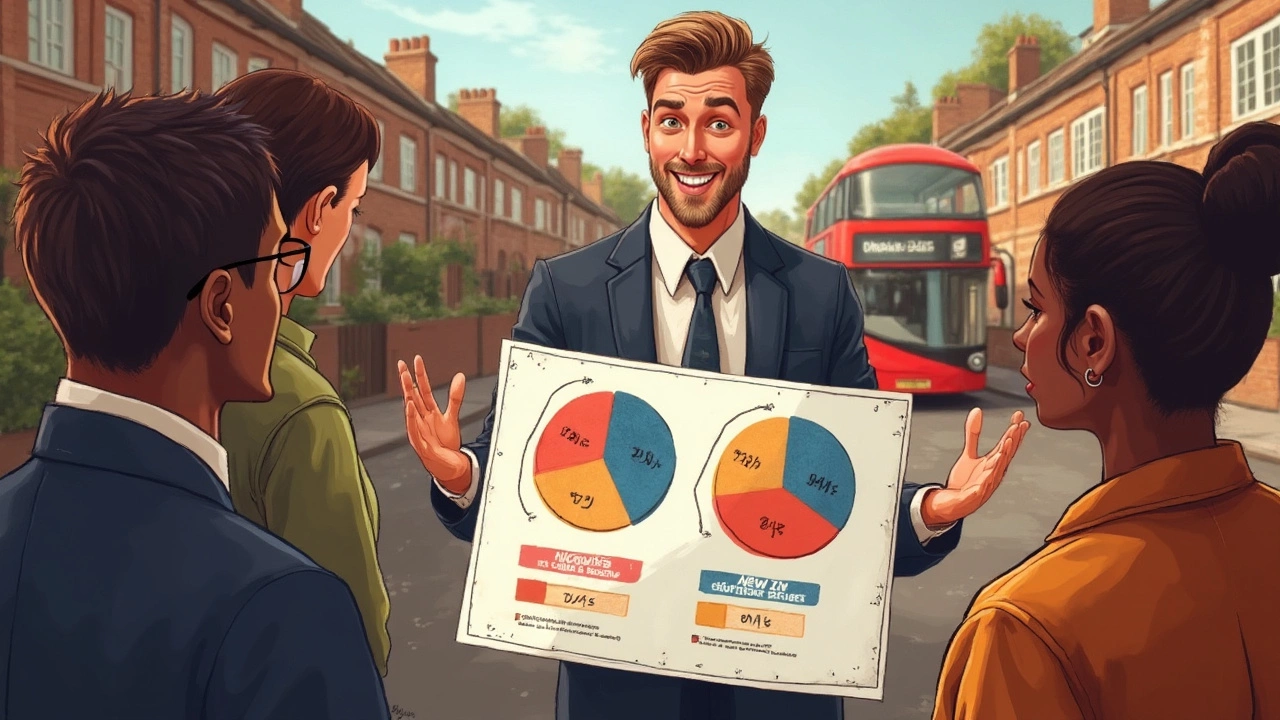Think owning a home is out of reach? Shared ownership flips the script, giving you the chance to buy a slice of a property—usually starting at 25%—while paying rent on the rest. This isn't some complicated loophole only for the lucky few; it's an option made for people who can't yet afford to buy the whole house.
The cool thing? You're not stuck with the same share forever. If you build up some savings or get a better-paying job, you can buy more chunks of the home over time. This process is called 'staircasing,' and it means you have real flexibility. Loads of people think once you pick your share, that's it. Not true.
But here's the thing: the pattern of share ownership can get confusing fast. Who owns what? Who pays for what? What does 'part-buy part-rent' actually look like month-to-month? Instead of wading through endless fine print, this guide lays it all out so you know exactly how it works in practice—plus how to make shared ownership work for you, not against you.
- How Shared Ownership Actually Works
- The Typical Share Ownership Patterns
- Increasing Your Share: Staircasing Explained
- Tips for Navigating Shared Ownership
How Shared Ownership Actually Works
Shared ownership is pretty straightforward once you know the basics. You buy a chunk of a home—could be 25%, 40%, even up to 75%—and pay rent on the rest to a housing association. It's designed for people who can't buy 100% of a house right away but want a legit way onto the property ladder. The best part? You only need a mortgage for your share, so the upfront deposit is way smaller than buying outright.
Here's what the whole process actually looks like:
- Eligibility: Not everyone can jump in. You usually have to be a first-time buyer or earn less than £80,000 a year (£90,000 in London).
- Pick a home — new or sometimes a resale from another shared owner.
- Decide the percentage you want to purchase. The minimum is usually 10% now, thanks to recent changes, but most start between 25–50%.
- Get a mortgage for your share. Housing associations will recommend mortgage advisors if needed.
- Start paying two things: your mortgage and rent on the share you don’t own (usually set at 2.75% of the unsold value, yearly, then divided into monthly payments).
- You’ll also pay some service charge and maintenance costs. These can add up, so budget for them.
If you want some hard numbers, check out this table. It breaks down how much you might pay upfront in 2025, based on the share you buy and a home worth £280,000.
| Share Bought | Deposit Needed (5%) | Monthly Mortgage (Estimate) | Monthly Rent |
|---|---|---|---|
| 25% | £3,500 | £350 | £480 |
| 50% | £7,000 | £700 | £320 |
| 75% | £10,500 | £1,050 | £160 |
The numbers above are just estimates, but they show how your costs change depending on your share. You pay less rent if you own more of the property, but your mortgage and deposit both go up. If you want to stay flexible and not overstretch, you can always buy more of your home later.
The main player here is the shared ownership scheme itself. It practically gives you a foot in the door of homeownership in areas where prices are sky-high, especially cities. If you're tired of paying full rent and not building any equity, this option hands you a share—plus the chance to increase ownership when you're ready.
The Typical Share Ownership Patterns
Shared ownership isn’t a one-size-fits-all deal, but most people start off by buying somewhere between 25% and 50% of a property. That’s the standard offer from housing associations and most new shared ownership developments in England and Wales. In Scotland, you’ll sometimes see shares as low as 10%. These entry points make it more doable for folks who were priced out of the traditional market.
Let’s say you buy a 30% share. You’ll pay a mortgage on your share and then a reduced rent (usually around 2.75% of the unsold value) to the housing association for the rest. So if the flat costs £250,000 and you buy 30%, you’d get a mortgage for £75,000 and pay rent on the remaining £175,000. This split means monthly costs are usually lower than renting privately or buying outright with a traditional mortgage.
Here’s how the split usually looks in real life:
- Shared ownership almost always starts at 25%, but some newer schemes lower the entry share to 10% for extra flexibility.
- The most common starting shares are: 25%, 30%, 40%, and 50%.
- You can sometimes choose your starting share, but it depends on your finances and what the housing provider allows.
- The bigger your share, the less rent you pay, but your mortgage bills go up.
The pattern stays the same: you own a portion and rent the rest from the housing association. Even if your starting share is small, you’re still legally considered a homeowner. Over time, most shared owners aim to increase that share—sometimes all the way to 100%, which means you eventually own the place outright and stop paying rent altogether (though you might still pay service charges).
Knowing these patterns makes budgeting easier and helps you plan if and when you want to buy a bigger slice later on.

Increasing Your Share: Staircasing Explained
"Staircasing" is just the industry term for buying a bigger stake in your shared ownership home. You start off owning a percentage—say 25%—but you’re allowed to increase this when you’re ready, sometimes all the way up to 100%. This step-by-step approach is a big deal for people who can't jump straight into full home ownership.
Most housing associations let you buy extra shares in chunks of at least 10%. Every time you staircase, the price depends on a fresh valuation by an independent surveyor. The higher the value of your home, the more you’ll pay for the slice you want to buy. On average, folks tend to staircase two or three times before reaching full ownership, though only about 5% go all the way to 100%.
Here’s how the staircasing process usually works:
- Tell your housing association you want to staircase.
- Get your home valued by a RICS-certified surveyor (not just any estate agent).
- Apply for a mortgage or use your savings for the extra share.
- Your contract gets updated, and your rent drops because you now pay rent only on the landlord's remaining share.
Here's a breakdown of what staircasing might look like in numbers:
| Your Share | Market Value | Amount Paid | Rent Paid (Monthly) |
|---|---|---|---|
| 25% | £200,000 | £50,000 | £411 |
| 50% | £210,000 | £105,000 | £308 |
| 75% | £220,000 | £165,000 | £154 |
| 100% | £230,000 | £230,000 | £0 |
As you up your share, your rent on the remaining chunk drops until it's gone completely at full ownership.
Now, a word of warning—there are costs to every step, like valuation fees, legal charges, and sometimes higher stamp duty if you hit 80% or more. So, crunch the numbers before each move. Some housing providers also set limits, so double-check if you have to staircase in minimum chunks or if you can go for smaller jumps.
Want to boost your shared ownership stake quicker? One idea is to watch for pay raises or set aside windfalls and bonuses. Plenty of people use remortgaging as their wages go up, turning rent money into home equity. It’s all about turning part-buy part-rent into something that’s more yours, chunk by chunk.
Tips for Navigating Shared Ownership
Nailing shared ownership takes more than just buying your first share. The details matter, and there's a lot you can do to stay on top of things, save money, and set yourself up for future success. Here’s what you need to watch out for:
- Shared ownership doesn’t mean you dodge all costs. You’ll still pay service charges, ground rent, and all the household bills. Every provider sets these a bit differently, so always ask for a breakdown before you sign anything.
- Get your paperwork sorted early. When you want to staircase (buy more shares), you’ll need a solicitor, a valuation report, and sometimes extra admin fees. Keeping all your property documents handy saves time and last-minute headaches.
- Be smart with staircasing. Your rent drops as you purchase more shares, but there may be new costs like valuation fees each time. Most folks do staircasing two or three times max, since every jump means extra costs.
- Learn the resale rules. If you own less than 100%, you usually have to give your provider the first chance to find a new buyer (this is called "nomination period"). After that, you can list the place on the open market. This can add a few weeks or even months to your move if you need to sell quickly.
Wondering how the money stacks up for shared owners? Check out this table with actual average monthly costs as of 2024 (based on a typical London two-bedroom flat):
| Cost | Monthly Average |
|---|---|
| Mortgage (25% share) | £410 |
| Rent (on 75% share) | £690 |
| Service Charge | £160 |
| Ground Rent | £25 |
| Total | £1,285 |
Keep an eye out for annual rent reviews. Your rent on the portion you don’t own can go up every April—usually linked to inflation. Right now, most housing associations use something called 'RPI + 0.5%' to set the new rate.
If you want less stress when moving up the property ladder, set reminders for key dates—like when you can next staircase or when your fixed mortgage rate ends. This way, you’re always a step ahead and never caught off guard by surprise bills or paperwork.


Corbin Fairweather
I am an expert in real estate focusing on property sales and rentals. I enjoy writing about the latest trends in the real estate market and sharing insights on how to make successful property investments. My passion lies in helping clients find their dream homes and navigating the complexities of real estate transactions. In my free time, I enjoy hiking and capturing the beauty of landscapes through photography.
view all postsWrite a comment